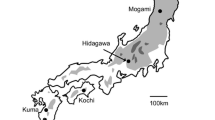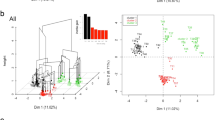Abstract
The cutoff used to determine sites of high biological diversity has the potential to influence which species are identified as relevant biological indicators. I␣used data on longhorned beetles and the IndVal program to conduct a sensitivity analysis by varying the definition of high diversity sites from the upper 50% of sites to the upper 5% of sites. The analysis was carried out at all levels of a site typology based on the tree species present at the forested sites. Three species emerged as strong indicators of high diversity sites. Although the indicator values for these species were almost always statistically significant within the upper level of the site typology (all forested sites) the definition of high diversity had a large impact on these values. All three species showed an increase in their indicator values with higher cutoffs for high diversity sites suggesting a relatively nested set of species.
Similar content being viewed by others
References
Aldenderfer MS, Blashfield RK (1984) Cluster analysis. Sage Publications Inc., Beverly Hills, California
Barbalat S (1998) Importance of forest structures on four beetle families (Col.: Buprestidae, Cerambycidae, Lucanidae and phytophagous Scarabaeidae) in the Areuse Gorges (Neuchâtel, Switzerland). Revue Suisse de Zoologie 105:569–580
Blackman MW, Stage HH (1924) On the succession of insects living in the bark and wood of dying, dead and decaying hickory. New York State College of Forestry at Syracuse University, Technical Publication No. 17, 3–269
Bray JR, Curtis JT (1957) An ordination of the upland forest communities of southern Wisconsin. Ecol Monogr 27:325–349
Brommit AG, Charbonneau N, Contreras TA, Fahrig L (2004) Crown loss and subsequent branch sprouting of forest trees in response to a major ice storm. J Torrey Bot Soc 131:169–176
Dajoz R (2000) Insects and forests. Intercept Ltd., Lavoisier Publishing, New York
Duelli P, Obrist MK (1998) In search of the best correlates for local organismal biodiversity in cultivated areas. Biodivers Conserv 7:297–309
Dufrêne M, Legendre P (1997) Species assemblages and indicator species: the need for a flexible asymmetrical approach. Ecol Monogr 67:345–366
Hanks LM (1999) Influence of the larval host plant on reproductive strategies of cerambycid beetles. Annu Rev Entomol 44:483–505
Holland JD, Bert D, Fahrig L (2004) Determining the spatial scale of species’ response to habitat. BioScience 54:227–233
Linsley EG (1954) Ecology of Cerambycidae. Annu Rev Entomol 4:99–138
Linsley EG, Chemsak JA (1997) The Cerambycidae of North America, part VIII: bibliography, index, and host plant index. University of California Press, California
Maeto K, Shigeho S, Miyata H (2002) Species diversity of longicorn beetles in humid temperate forests: the impact of forest management practices on old-growth forest species in southwestern Japan. Biodivers Conserv 11:1919–1937
McGeoch MA (1998) The selection, testing and application of terrestrial insects as bioindicators. Biol Rev Cambridge Philos Soc 73:181–201
Nilsson SG, Hedin J, Niklasson M (2001) Biodiversity and its assessment in boreal and nemoral forests. Scand J Forest Res 16(Supplement 3):10–26
Ohsawa M (2004) Species richness of Cerambycidae in larch plantations and natural broad-leaved forests of the central mountainous regions of Japan. Forest Ecol Manage 189:375–385
Økland B, Bakke A, Hågvar S, Kvamme T (1996) What factors influence the diversity of saproxylic beetles? A multiscaled study from a spruce forest in southern Norway. Biodivers Conserv 5:75–100
Oliver I, Beattie AJ (1996) Designing a cost-effective invertebrate survey: a test of methods for rapid assessment of biodiversity. Ecol Appl 6:594–607
Schulze CH, Waltert M, Kessler PJA, Pitopang R, Shahabuddin, Veddeler D, Muhlenberg M, Gradstein SR, Leuschner C, Steffan-Dewenter I, Tscharntke T (2004) Biodiversity indicator groups of tropical land-use systems: comparing plants, birds, and insects. Ecol Appl 14:1321–1333
Shibata E, Sato S, Sakuratani Y, Sugimoto T, Kimura F, Ito F (1996) Cerambycid beetles (Coleoptera) lured to chemicals in forests of Nara Prefecture, central Japan. Ann Entomol Soc Am 89:835–842
Speight MCD (1989) Saproxylic invertebrates and their conservation. Council of Europe, Strasbourg
Yanega D (1996) Field guide to northeastern longhorned beetles (Coleoptera: Cerambycidae). Illinois Natural History Survey, Champaign, Illinois
Acknowledgements
The author thanks Marc Dufrêne for help with implementing the IndVal program, and Amanda North and Jacob Rowland for assistance summarizing the results. The manuscript was improved by reviews by Pat McCafferty and Yssa DeWoody. This is Purdue Agricultural Research Programs manuscript number 2005-17731.
Author information
Authors and Affiliations
Corresponding author
Rights and permissions
About this article
Cite this article
Holland, J.D. Sensitivity of Cerambycid Biodiversity Indicators to Definition of High Diversity. Biodivers Conserv 16, 2599–2609 (2007). https://doi.org/10.1007/s10531-006-9066-1
Received:
Accepted:
Published:
Issue Date:
DOI: https://doi.org/10.1007/s10531-006-9066-1




